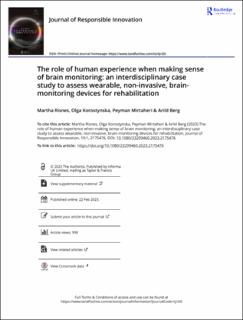The role of human experience when making sense of brain monitoring: an interdisciplinary case study to assess wearable, non-invasive, brain-monitoring devices for rehabilitation
Peer reviewed, Journal article
Published version
Permanent lenke
https://hdl.handle.net/11250/3097409Utgivelsesdato
2023Metadata
Vis full innførselSamlinger
Sammendrag
Wearable, non-invasive, brain-monitoring technologies could takeresearch outside the laboratory, to make discoveries about thehuman brain in different, and sometimes more relevant, settingsfor the specific research. While this could lead to new scientificdiscoveries, there is a need to understand how individuals benefitfrom and make sense of interactions with such technology. Thisstudy considered patient experiences with wearable, non-invasive, brain-monitoring devices in a rehabilitation context. Theresearch project Patient-Centric Engineering in Rehabilitation(PACER) provided examples from research practice to assess anddiscuss the potential for using such devices in patient-centricrehabilitation for lower limb amputees. Projectfindings suggestthat concepts from technology mediation theory strengthen thediscussion by describing how relations with the technology differ,depending on whether you are a health professional, researcheror patient, which is an essential understanding when assessingnovel technologies for practical applications.

